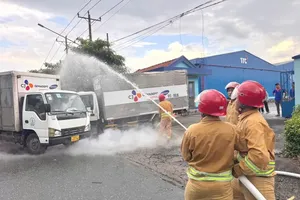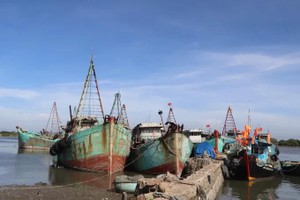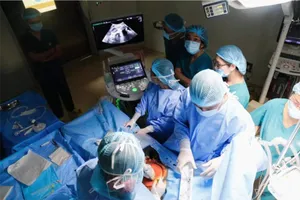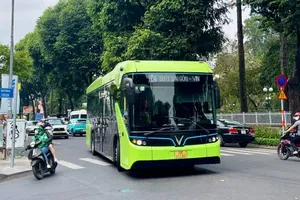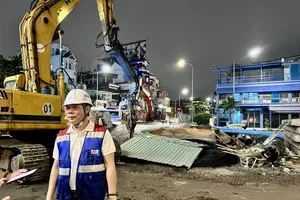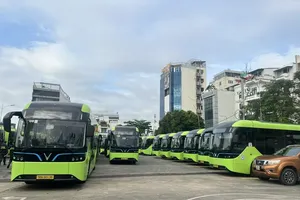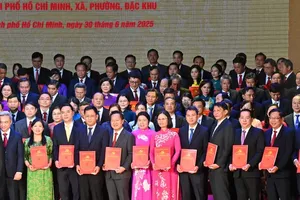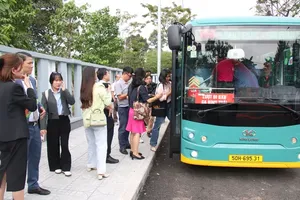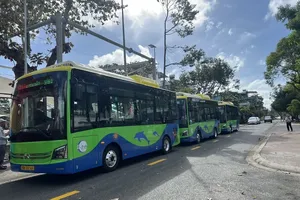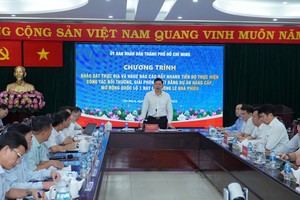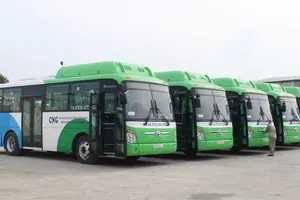 |
Wastewater produced by daily activities is discharged directly into canals, rivers |
Plans of building new sludge wastewater treatment plants are facing difficulties due to limited capital and inadequacies in the operation of some existing factories.
Wastewater is discharged directly into rivers and canals
Every morning, resident Le Thi Ha in Tran Nao Street of Thu Duc City’s An Khanh Ward does exercises on the bank of the Saigon River breathing fresh air. She said that the bank of the Saigon River has been renovated very spaciously and cleanly, so everyone has a green space to do exercise but she moaned about the fishy smell from the sewer lines in the residential area flowing straight into the river unpleasantly.
It is noticeable that not only in the area along the Saigon River in Thu Duc City but many drainage pipes connected from residential areas such as Ben Van Don in District 4 and Tau Hu canal area in District 8 also directly discharge domestic wastewater into rivers and canals.
According to environmental experts, improperly-treated domestic wastewater discharged into the natural environment will cause a negative impact on the soil and water environment and indirectly affect human health. In particular, it is likely to adversely affect the plan to develop waterway transport associated with tourism of Ho Chi Minh City.
The city Department of Construction reported that the city has presently 7 wastewater treatment plants, including three centralized wastewater treatment plants - Binh Hung wastewater treatment plant with a treatment capacity of 469,000 cubic meters a day, Binh Hung Hoa wastewater treatment plant with a treatment capacity of 30,000 cubic meters a day and Tham Luong - Ben Cat wastewater treatment plant with a treatment capacity of 131,000 cubic meters a day.
In addition, there are 4 wastewater treatment stations in residential areas including the Tan Quy Dong wastewater treatment station in District 7 with a treatment capacity of 500 cubic meters a day, the wastewater treatment station in Vinh Loc B resettlement quarter in Binh Chanh outlying district with a treatment capacity of 3,700 cubic meters a day, the wastewater treatment station in a 17.3ha resettlement area and a 38.4ha resettlement area in Thu Duc City’s Binh Khanh Ward with a treatment capacity of 3,000 cubic meters and 150 cubic meters a day respectively.
The total design capacity of the plants for wastewater treatment is about 644,200 cubic meters per day, but the current treatment capacity is only 40.8 percent. According to the HCMC Department of Construction, the investment and operation of wastewater treatment plants still face certain difficulties; amongst them, the biggest difficulty is meager investment capital.
Infrastructure is out of sync
Responsible agencies admitted that the wastewater treatment plant is not running at full capacity, which is one of the reasons for the low rate of wastewater treatment in the city. For example, the Tham Luong - Ben Cat Wastewater Treatment Plant has a capacity of 131,000 cubic meters per day but is currently operating at only 10 percent as per statistics of the Technical Infrastructure Agency under the Ministry of Construction.
A representative of the Urban Infrastructure Construction Investment Project Management Board in Ho Chi Minh City explained that about 10 years ago, the city had planned to synchronize sewer lines for wastewater collection. This collection system is a part of the World Bank-funded flood risk management project in Ho Chi Minh City which has been designed to build common sewer lines for rainwater and wastewater and 6 wells to separate the flow to lead wastewater into the Tham Luong - Ben Cat wastewater treatment plant.
However, due to a disagreement with the World Bank on compensation and site clearance policy, in 2017 the project had to be canceled. Meanwhile, Nhieu Loc - Thi Nghe Wastewater Treatment Plant with a capacity of 480,000cubic meters per day in the second phase was also deployed 10 years ago but it has so far not been able to operate due to many hiccups along the way despite the existing sewage collection pipeline system. According to the newly approved project schedule, the factory is expected to be completed in 2025.
Experts said that the southern largest city has been experiencing a high rate of urbanization, but wastewater treatment in residential areas and large urban areas has not kept up with demand. The lack of capital to invest in wastewater treatment plants is a major difficulty that the city is facing. Thus, for meeting the needs of urban wastewater treatment, the city needs to review the current mechanisms and policies to mobilize all resources and investment attraction policies must be changed in the orientation to social contributions and investment cooperation to speed up the progress of lengthily delayed projects.
In his Decision No. 1942/QD-TTg dated October 29, 2014, the Prime Minister approved for Ho Chi Minh City to invest in 9 new wastewater treatment plants comprising the plant No. 2 in Tan Phu District with treatment capacity of 230,000 cubic meters per day, the factory No. 3 in Binh Chanh District with treatment capacity of 270,000 cubic meters per day, the factory No. 4 in Nha Be District with treatment capacity of 132,000 cubic meters per day, the factory No. 6 with a capacity of 132,000 cubic meters per day and the factory No. 7 with a capacity of 230,000 cubic meters per day in Thu Duc City.
The other ones include the factory No. 8 in District 12 with a capacity of 310,000 cubic meters per day, the factory No. 10 in Binh Tan District with a capacity 180,000 cubic meters per day, the plant No. 11 in Hoc Mon outlying district with a capacity 120,000 cubic meters per day, the factory No. 12 in Cu Chi outlying district with a capacity of 110,000 cubic meters per day. Up to now, all these projects have not been implemented yet.
